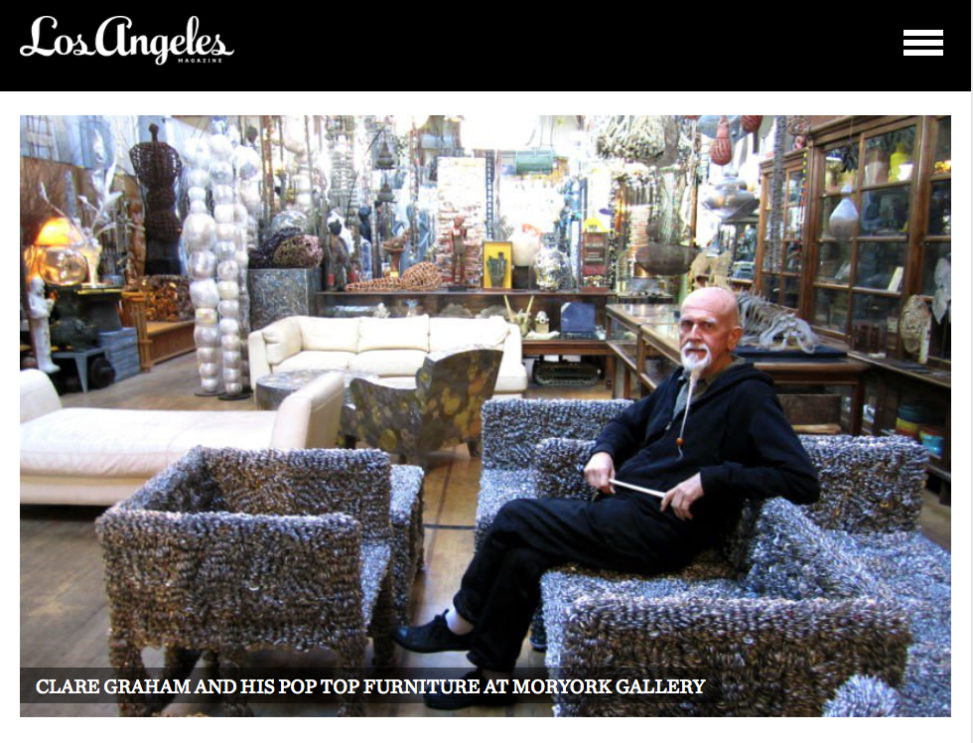Patrick Quinn for LA Magazine
Stepping into artist Clare Graham’s MorYork Gallery in Highland Park is like taking a trip through the mirror with Alice
Until recently, Highland Park was a sleepy community that most Angelenos saw only as a blur from the 110 Freeway. Then one morning, the neighborhood woke up to discover that it had become an overnight celebrity. But back in the ‘80s, a group of artists had already discovered the cheap studios for lease in the area. Since then, many of the area’s artists have been forced out by rising rents. But one remains at the intersection of York Blvd. and Avenue 50. That’s where you’ll find MorYork Studios and its resident craftsman, Clare Graham. The building is full of his creations along with an amazing collection of antiques, artifacts, and other curious items. Like a trip through the mirror with Alice, MorYork inspires the imagination and Clare Graham is your tour guide.
We spoke with Graham about MorYork, Highland Park, and the virtue of good craftsmanship. Check out Graham’s work at the recurring intimate concert series Secret Songs featuring Clinton Patterson, Don Heffington, and Lonesome Leash at MorYork Gallery, March 27 2015.
Is it correct that MorYork was originally built in 1933 as a Safeway Market?
CG: The old trolley car actually stopped in front of the building back then. It was the end of the line so the seats reversed themselves and it went back down York to Figueroa and all the way to downtown.
We have one image from the Los Angeles Library that was shot out in front of what used to be the insurance building but is now Café De Leche. The main part of the image is the old trolley. And behind it you can sort of see the frieze on the top of our building. First it was the market, and then it was a roller skating rink in the ‘50s. When we bought the building, there were boxes of roller skates up in the rafters. There used to be a snack bar and restrooms down one side of the building. There were slot-car races in the ‘60s for a brief time. Then J.J. Jewelcraft had it for a long run; about 25 years. But it was empty and derelict for probably two years before we bought it in 1986.
MorYork is often described as a Wunderkammer, the German phrase for Cabinet of Curiosities.
CG: The collections of stuff provide portals for people to be involved in something that they know intimately. They think; why would he take a hundred and fifty thousand jigsaw puzzle pieces and put them in a box like that? There’s always something that they’re left questioning about it. I think most people leave not knowing if it’s about the individual objects or if it’s an instillation or what it really is.
Tell us about your work. What inspired you to create the kind of things you do?
CG: I was always a collector. When I was young, I had shoeboxes in my closet filled with leaves and rocks and animal bones, things I picked up. This building is really just a large archive of tangible artifacts and great ideas I’ve run into that I don’t want to lose track of. I don’t really keep sketchbooks of projects, but I have an artifact I can go to and rekindle that aesthetic epiphany you get when you see something and it prompts an idea. Then you try and get 10,000 more of them to do something with. When I was doing all the pop-tops stuff, I had twelve 35-gallon trash containers filled with pop-tops. That’s a considerable quantity, that’s millions. [Graham created furniture made purely out of soda can pop-top tabs]
You’ve said that you aren’t an artist so much as a craftsman.
CG: I think this is at the root of what I’m trying to represent right now. I went to school during the period when craft was in its ascendency as a legit sort of separate profession from being an artist. But what had happened was Peter Voulkos, Ken Price, and John Mason were ceramicists. They were potters, basically. They started expanding how clay was seen and they did these magnificent works, but they were no longer throwing pots on the wheel. They were creating sculpture.
They kind of abandoned what was craft and became fine artists and they wanted their work to be sold at prices commiserate with the prices that abstract expressionism and Warhol’s were selling for at the time. And yes, they deserved it, but they threw craftsmen under the bus. Suddenly it was Etsy.
Do you have any words of advice for younger artists getting started?
CG: You have to pay attention to the lessons of Joseph Cornell and Lee Bonteciau who produced incredible work, but during their lifetime were mostly solitary, totally off the radar, gave up the gallery scene, didn’t participate but produced a body of work that turns out to be more significant than anybody else who was marquee at the time. You need to keep doing it. You see so many young artists today who are using craft processes making fine art, and their craftsmanship is shit. They just don’t have the developed ability. And whichever one you’re going to do, you need to master your craft. You have to be a good painter, or a good woodworker, or a good ceramicist. You can’t call it art, and say that the craftsmanship doesn’t matter because it’s still communicating the ideas.
http://www.lamag.com/clare graham

Leave a Reply